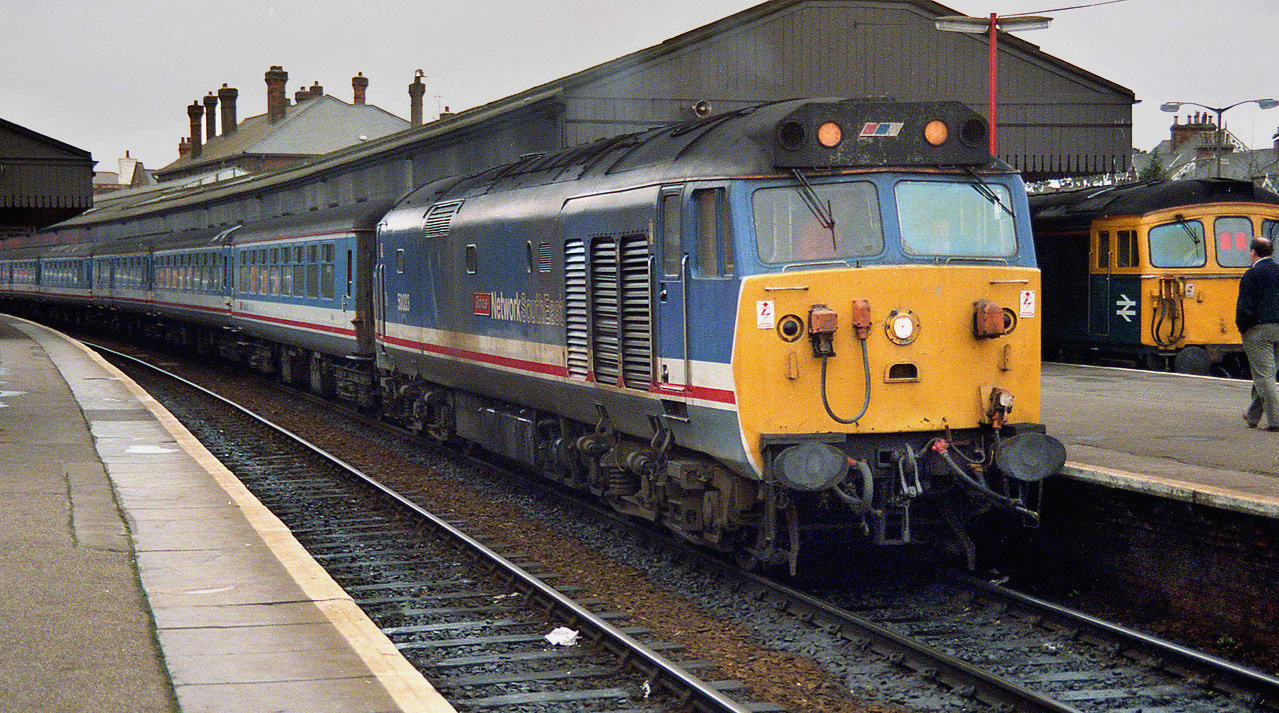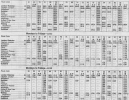WesternLancer
Established Member
- Joined
- 12 Apr 2019
- Messages
- 10,864
Thanks for explaining, sorry of my original post was unclearOk - I read it “the other way around”.
Thanks for explaining, sorry of my original post was unclearOk - I read it “the other way around”.
Yeah. 1993.Can I just check you do mean 1993 and not 1893...?
Also, what time would trains stop running? I'm planning to have my character leave for London sometime in the evening. And, how long would the commute be?Hi! This is my first time on this forum.
I’m writing a fictional story set in the UK in 1993 and would really appreciate some help understanding what train travel would have been like during that time, particularly for a journey from Surrey (Woking, specifically) to London (ideally Waterloo, though anywhere in Central London would work).
Would it have been possible to travel from Surrey to London by train in 1993? If so, what kind of trains or stations would have been involved?
I’m also curious about how a passenger would have paid for that fare—would they typically use cash at a manned ticket booth, a machine, or purchase in some other way?
And finally, if anyone is willing, I’d be very grateful for a general walk-through of what a passenger in 1993 might do from buying a ticket in a station in Surrey to arriving in London.
Thank you so much in advance!
You’re probably ok till at least 10pm (and later going the other way). Journey time - as stated earlier - between 25 and 40 minutes, depending on the number of stops.Also, what time would trains stop running? I'm planning to have my character leave for London sometime in the evening. And, how long would the commute be?
As has been noted above, plenty of reading of business papers and documents went on. But writing was another matter. Most of the slam door stock rode sufficiently roughly that writing anything lengthy was a decided challenge. Capital letters for crosswords were fine, but lower case annotations to documents tended towards the illegible - and gave rise to much criticism from PAs and typists asked to interpret them later! Special recognition to those folk who managed to smarten up their make-up successfully as their train hit the points just before their destination!
* If you wanted a seat in the morning on the fast trains, there was a good chance of getting one at the very back of the train
The OP has mentioned that they are looking at a passenger heading into London in the evening - so the info about commuting patterns of behaviour that many of us had assumed are probably not the ones the OP will be thinking of now I think about it.The slam door stock would (certainly in the morning peak at London) have seen the mass opening and disembarking of hordes of passengers before the train was stopped.
Many city workers would be expected to be suited up, their newspapers read on the train in.
The OP has mentioned that they are looking at a passenger heading into London in the evening - so the info about commuting patterns of behaviour that many of us had assumed are probably not the ones the OP will be thinking of now I think about it.
The 455s did not regularly run on the Waterloo- Surbiton - Woking - Guildford services: they were usually VEPs, with 1st and 2nd class. The 455s do now reach Woking as the construction of the bay there means they can terminate there, and no longer continue to Guildford.The one on the right is one with manually opening hinged doors for passengers (all doors closed in the picture so not obvious), such train have all now been withdrawn - the train on the left is one that you could still travel on from Waterloo today - though unsure if that type would have served the route to Woking.
I was hoping someone would clarify that - many thanksThe 455s did not regularly run on the Waterloo- Surbiton - Woking - Guildford services: they were usually VEPs, with 1st and 2nd class. The 455s do now reach Woking as the construction of the bay there means they can terminate there, and no longer continue to Guildford.
The 455s DID run to Woking on the route via Chertsey, but I don't recall if that was still running in 1993 (I recall using it in 1986)
Not many 455s at Woking in 1993.F
You'd have been on slam door stock or (ideally) an NSE-liveried Class 455 that would have looked like this inside;


Indeed - in 1993 the usual route from Heathrow to central London would be by the Piccadilly Line or by one of the several express (road) coach routes.One thought. I hope the OP hasn’t got his character at Woking as part of a journey from Heathrow Airport to central London: that would be a very unusual route. It would be best to start a new thread if that is the case.
IIRC the Waterloo-Guildford via Woking stoppers were operated with 455s for a short period, from around May 1992 to May 1997. I recall the traditional '73' Waterloo-Portsmouth and Southsea stopper being split into two separate services either side of Guildford in May 1992 and I seem to remember that this was so that 455s could be used north of Guildford.The 455s did not regularly run on the Waterloo- Surbiton - Woking - Guildford services: they were usually VEPs, with 1st and 2nd class. The 455s do now reach Woking as the construction of the bay there means they can terminate there, and no longer continue to Guildford.

Did Chertsey services to Woking really start as early as 1986? Not saying they didn't but I had it in my head that they began in 1988. They were definitely there by March 1989 as I used one.The 455s DID run to Woking on the route via Chertsey, but I don't recall if that was still running in 1993 (I recall using it in 1986)
Not many 455s at Woking in 1993.
Slam door stock on the local services and the Porstmouth line, but passengers from Woking to Waterloo generally choose the fast services. These were the then fairly-new 442s on the Southampton and Bournemouth fasts, and probably still loco-hauled on the Exeter fasts (the new diesel units for the Exeter line started to be introduced from mid 1993)
Pictures show a class 50 and train in NSE livery - the first is at, I think, Woking. The other I'm not sure - Salisbury?


First one is platform 2 at WokingNot many 455s at Woking in 1993.
Slam door stock on the local services and the Porstmouth line, but passengers from Woking to Waterloo generally choose the fast services. These were the then fairly-new 442s on the Southampton and Bournemouth fasts, and probably still loco-hauled on the Exeter fasts (the new diesel units for the Exeter line started to be introduced from mid 1993)
Pictures show a class 50 and train in NSE livery - the first is at, I think, Woking. The other I'm not sure - Salisbury?


(Reply about the Chertsey-Woking service posted in this thread: https://www.railforums.co.uk/thread...ervice-have-to-wait-at-virginia-water.288662/).Did Chertsey services to Woking really start as early as 1986? Not saying they didn't but I had it in my head that they began in 1988. They were definitely there by March 1989 as I used one.
Do you mean leaving London in the evening, or heading to London in the evening? 'Commute' usually refers to workers catching the same train day in, day out; few would travel (commute) to work in the evening, unless maybe they were in the newspaper business, but Fleet Street was beginning to cease being the centre for producing newspapers by 1993.Also, what time would trains stop running? I'm planning to have my character leave for London sometime in the evening. And, how long would the commute be?
Could generally get suburban trains back from London until about 23:30 with some routes last trains being after Midnight.Also, what time would trains stop running? I'm planning to have my character leave for London sometime in the evening. And, how long would the commute be?
Note - the OP is talking about evening trains up to London. Anyone arriving in the late evening (particularly after 10, by which time “last trains” would be leaving) would very much have the impression they were going “against the flow”. That flow could be an eclectic mixture of the tired and weary, the well- dressed concert and theatre crowd (obviously a bit later) clutching their programmes, and the over-exuberant (putting it politely).Could generally get suburban trains back from London until about 23:30 with some routes last trains being after Midnight.
Until Autumn 1998 (date from memory) pubs had defined drinking hours and called closing time at 11pm. In the business districts (The City of London), many shut earlier Monday-Wednesday at around 9pm as their customers would drink at lunchtime or after work, not late into evening. The business area (City) would be virtually dead after 9pm (except Fridays) and was like a ghost town at weekends.
Late evening activities tended to be in a part of London called the West End, and apart from nightclubs were generally all closed by 23:30. To some extent these hours were still fairly common in 1993 as decades of fixed closing hours had defined peoples behaviour, it did slowly slip until nearer midnight through the 1990s, but trying to leave after about 00:15 would not have meant no tubes or bus in London, and no train home, until breakfast time.
Could generally get suburban trains back from London until about 23:30 with some routes last trains being after Midnight.
Until Autumn 1998 (date from memory) pubs had defined drinking hours and called closing time at 11pm. In the business districts (The City of London), many shut earlier Monday-Wednesday at around 9pm as their customers would drink at lunchtime or after work, not late into evening. The business area (City) would be virtually dead after 9pm (except Fridays) and was like a ghost town at weekends.
Late evening activities tended to be in a part of London called the West End, and apart from nightclubs were generally all closed by 23:30. To some extent these hours were still fairly common in 1993 as decades of fixed closing hours had defined peoples behaviour, it did slowly slip until nearer midnight through the 1990s, but trying to leave after about 00:15 would not have meant no tubes or bus in London, and no train home, until breakfast time.
There was of course the famous 0105 Waterloo-Southampton. Definitely existed in May 1994, as the WTT for that date is available from Network Rail. This called at Vauxhall, Wimbledon, Surbiton and Woking.
You also had the 0005 to Guildford (all stations from Surbiton) and the 0030 to Portsmouth Harbour.
Maybe a bit OT but does anyone remember when the 0105 started? I'm sure I remember seeing it in timetables in the 80s, though it didn't exist in 1982.
Looking at today's timetables incidentally I see that late night Waterloo-Southampton appears to have been dramatically cut back post-Covid. Not only does the 0105 not seem to exist anymore, but neither does the 0005. Last train back is 2335, whereas in 1994 there was a 2353 in addition to the 0105. So the current late-night service is probably worse than what existed in the late 80s, if my memories of the 0105 existing in the 80s are accurate - and certainly worse than the 1994 offering.
